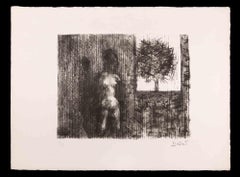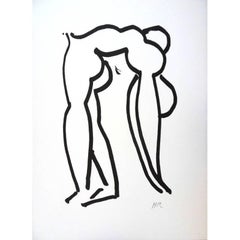Jacques Busse Nude Prints
to
1
1
1
Overall Height
to
Overall Width
to
1
1
1
1
1
1
2
101
61
53
50
1
Artist: Jacques Busse
Nude Woman with Tree - Original Lithograph by Jacques Busse - Mid 20th Century
By Jacques Busse
Located in Roma, IT
Nude woman with tree is an original artwork realized by French artist Jacques Busse (1922-2004)
Lithograph print.
Hand-signed on the lower right in pe...
Category
Mid-20th Century Modern Jacques Busse Nude Prints
Materials
Lithograph
Related Items
after Henri Matisse - Acrobat
By Henri Matisse
Located in Collonge Bellerive, Geneve, CH
after Henri Matisse - Acrobat
Edition of 200
with the printed signature, as issued
76 x 56
With stamp of the Succession Matisse
References : Artvalue - Succession Matisse
Category
1950s Modern Jacques Busse Nude Prints
Materials
Lithograph
Marc Chagall - Moses - Original Lithograph
By Marc Chagall
Located in Collonge Bellerive, Geneve, CH
Marc Chagall, Original Lithograph depicting an instant of the Bible.
Technique: Original lithograph in colours
Year: 1956
Sizes: 35,5 x 26 cm / 14" x 10.2" (sheet)
Published by: Éditions de la Revue Verve, Tériade, Paris
Printed by: Atelier Mourlot, Paris
Documentation / References: Mourlot, F., Chagall Lithograph [II] 1957-1962, A. Sauret, Monte Carlo 1963, nos. 234 and 257
Marc Chagall (born in 1887)
Marc Chagall was born in Belarus in 1887 and developed an early interest in art. After studying painting, in 1907 he left Russia for Paris, where he lived in an artist colony on the city’s outskirts. Fusing his own personal, dreamlike imagery with hints of the fauvism and cubism popular in France at the time, Chagall created his most lasting work—including I and the Village (1911)—some of which would be featured in the Salon des Indépendants exhibitions. After returning to Vitebsk for a visit in 1914, the outbreak of WWI trapped Chagall in Russia. He returned to France in 1923 but was forced to flee the country and Nazi persecution during WWII. Finding asylum in the U.S., Chagall became involved in set and costume design before returning to France in 1948. In his later years, he experimented with new art forms and was commissioned to produce numerous large-scale works. Chagall died in St.-Paul-de-Vence in 1985.
The Village
Marc Chagall was born in a small Hassidic community on the outskirts of Vitebsk, Belarus, on July 7, 1887. His father was a fishmonger, and his mother ran a small sundries shop in the village. As a child, Chagall attended the Jewish elementary school, where he studied Hebrew and the Bible, before later attending the Russian public school. He began to learn the fundamentals of drawing during this time, but perhaps more importantly, he absorbed the world around him, storing away the imagery and themes that would feature largely in most of his later work.
At age 19 Chagall enrolled at a private, all-Jewish art school and began his formal education in painting, studying briefly with portrait artist Yehuda Pen. However, he left the school after several months, moving to St. Petersburg in 1907 to study at the Imperial Society for the Protection of Fine Arts. The following year, he enrolled at the Svanseva School, studying with set designer Léon Bakst, whose work had been featured in Sergei Diaghilev's Ballets Russes. This early experience would prove important to Chagall’s later career as well.
Despite this formal instruction, and the widespread popularity of realism in Russia at the time, Chagall was already establishing his own personal style, which featured a more dreamlike unreality and the people, places and imagery that were close to his heart. Some examples from this period are his Window Vitebsk (1908) and My Fianceé with Black Gloves (1909), which pictured Bella Rosenfeld, to whom he had recently become engaged.
The Beehive
Despite his romance with Bella, in 1911 an allowance from Russian parliament member and art patron Maxim Binaver enabled Chagall to move to Paris, France. After settling briefly in the Montparnasse neighborhood, Chagall moved further afield to an artist colony known as La Ruche (“The Beehive”), where he began to work side by side with abstract painters such as Amedeo Modigliani and Fernand Léger as well as the avant-garde poet Guillaume Apollinaire. At their urging, and under the influence of the wildly popular fauvism and cubism, Chagall lightened his palette and pushed his style ever further from reality. I and the Village (1911) and Homage to Apollinaire (1912) are among his early Parisian works, widely considered to be his most successful and representative period.
Though his work stood stylistically apart from his cubist contemporaries, from 1912 to 1914 Chagall exhibited several paintings at the annual Salon des Indépendants exhibition, where works by the likes of Juan Gris, Marcel Duchamp and Robert Delaunay were causing a stir in the Paris art world. Chagall’s popularity began to spread beyond La Ruche, and in May 1914 he traveled to Berlin to help organize his first solo exhibition, at Der Sturm Gallery. Chagall remained in the city until the highly acclaimed show opened that June. He then returned to Vitebsk, unaware of the fateful events to come.
War, Peace and Revolution
In August 1914 the outbreak of World War I precluded Chagall’s plans to return to Paris. The conflict did little to stem the flow of his creative output, however, instead merely giving him direct access to the childhood scenes so essential to his work, as seen in paintings such as Jew in Green (1914) and Over Vitebsk (1914). His paintings from this period also occasionally featured images of the war’s impact on the region, as with Wounded Soldier (1914) and Marching (1915). But despite the hardships of life during wartime, this would also prove to be a joyful period for Chagall. In July 1915 he married Bella, and she gave birth to a daughter, Ida, the following year. Their appearance in works such as Birthday (1915), Bella and Ida by the Window (1917) and several of his “Lovers” paintings give a glimpse of the island of domestic bliss that was Chagall’s amidst the chaos.
To avoid military service and stay with his new family, Chagall took a position as a clerk in the Ministry of War Economy in St. Petersburg. While there he began work on his autobiography and also immersed himself in the local art scene, befriending novelist Boris Pasternak, among others. He also exhibited his work in the city and soon gained considerable recognition. That notoriety would prove important in the aftermath of the 1917 Russian Revolution when he was appointed as the Commissar of Fine Arts in Vitebsk. In his new post, Chagall undertook various projects in the region, including the 1919 founding of the Academy of the Arts. Despite these endeavors, differences among his colleagues eventually disillusioned Chagall. In 1920 he relinquished his position and moved his family to Moscow, the post-revolution capital of Russia.
In Moscow, Chagall was soon commissioned to create sets and costumes for various productions at the Moscow State Yiddish...
Category
1950s Modern Jacques Busse Nude Prints
Materials
Lithograph
Nude drawing (Nude on her haunches draws )
By Joseph Hirsch
Located in New Orleans, LA
A nude woman squats on her haunches as she draws an image on a sheet of paper. Joseph Hirsch created this lithograph in 1963 in an edition of 50. It was printed by Lucien Dutruit i...
Category
1960s American Modern Jacques Busse Nude Prints
Materials
Lithograph
'Eyes for the Night' — Mid-century Modernism
By Benton Murdoch Spruance
Located in Myrtle Beach, SC
Benton Spruance, 'Eyes for the Night', lithograph, 1947, edition 35, Fine and Looney 260. Signed, dated, titled, and annotated 'Ed 35' in pencil. A fine impression, on heavy, cream ...
Category
1940s American Modern Jacques Busse Nude Prints
Materials
Lithograph
'Chamonix' Mid-Century Hand Signed Original Lithograph.
By Joan Gardy Artigas
Located in Cotignac, FR
Mid-Century original lithograph entitled " Chamonix " hand signed by Joan Gardy Artigas and numbered 12/75 on arches vellum rag paper from the 1966-70 edition. Presented in period 19...
Category
Mid-20th Century Modern Jacques Busse Nude Prints
Materials
Lithograph, Printer's Ink, Rag Paper
H 30.5 in W 14.75 in D 0.5 in
September Morn
By Joseph Hirsch
Located in New Orleans, LA
Three women strolling on a beach. This impression is one of the rare impressions printed monochromatically. Hirsch natural inclination was to print in lack and white but reprinted ...
Category
1960s American Modern Jacques Busse Nude Prints
Materials
Lithograph
'Girl with Hands to Face' — Mid-century Modernism
By Benton Murdoch Spruance
Located in Myrtle Beach, SC
Benton Spruance, 'Girl with Hands to Face', two-color lithograph, 1940, edition 30, Fine and Looney 180. Signed, titled, and annotated 'Ed. 30' in pencil. A superb impression, on cr...
Category
1940s American Modern Jacques Busse Nude Prints
Materials
Lithograph
after Henri Matisse - Sleeping Blue Nude - Lithograph
By (after) Henri Matisse
Located in Collonge Bellerive, Geneve, CH
after Henri MATISSE
Edition of 200
with the printed signature, as issued
76 x 56 cm
With stamp of the Succession Matisse
References : Artvalue - Succession Matisse
Category
1950s Modern Jacques Busse Nude Prints
Materials
Lithograph
H 29.93 in W 22.05 in D 0.04 in
Modern Abstract Red & Purple Toned Figurative Lithograph of Nude Changing Woman
By Bruno Bruni
Located in Houston, TX
Modern abstract red and purple toned offset lithograph of a female figure by Italian artist Bruno Bruni. The work features a loosely rendered nude woman bent over in the process of c...
Category
Mid-20th Century Modern Jacques Busse Nude Prints
Materials
Lithograph
H 22.63 in W 18.5 in D 1.75 in
Femme Nue Assise dans l’Herbe, Cubist Lithograph by Pablo Picasso
By Pablo Picasso
Located in Long Island City, NY
A lithograph from the Marina Picasso Estate Collection after the Pablo Picasso painting "Femme Nue Assise dans l'Herbe". The original painting was completed in 1961. In the 1970's a...
Category
1980s Modern Jacques Busse Nude Prints
Materials
Lithograph
Leonor Fini - Duo - Original Lithograph
By Leonor Fini
Located in Collonge Bellerive, Geneve, CH
Leonor Fini - Duo - Original Lithograph
The Flowers of Evil
1964
Conditions: excellent
Edition: 500
Dimensions: 46 x 34 cm
Editions: Le Cercle du Livre Précieux, Paris
Unsigned and...
Category
1960s Modern Jacques Busse Nude Prints
Materials
Lithograph
Jacques Lipchitz French Cubist Modernist Lithograph Hebrew Judaica ZIon
By Jacques Lipchitz
Located in Surfside, FL
Hand signed and numbered.
with Hebrew calligraphy "Zion"
Chaim Jacob Lipchitz, 1891-1973, was born in Lithuania and came of age in Paris during the early 20th century, where he was...
Category
1960s Modern Jacques Busse Nude Prints
Materials
Lithograph
Jacques Busse nude prints for sale on 1stDibs.
Find a wide variety of authentic Jacques Busse nude prints available for sale on 1stDibs. You can also browse by medium to find art by Jacques Busse in lithograph and more. Much of the original work by this artist or collective was created during the 20th century and is mostly associated with the modern style. Not every interior allows for large Jacques Busse nude prints, so small editions measuring 15 inches across are available. Customers who are interested in this artist might also find the work of Henri Fantin-Latour, Toyen Marie Cerminova, and Edouard Chimot. Jacques Busse nude prints prices can differ depending upon medium, time period and other attributes. On 1stDibs, the price for these items starts at $277 and tops out at $277, while the average work can sell for $277.


